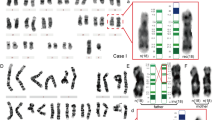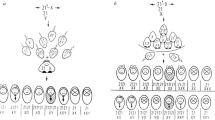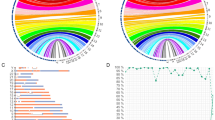Abstract
We report a large series of 173 patients with physical and/or neurological abnormalities and a de novo imbalance identified by array CGH. Breakpoint intervals were screened for the presence of low copy repeats (LCRs) to distinguish between rearrangements formed by non-allelic homologous recombination (NAHR) and rearrangements formed by other mechanisms. We identified significant differences in size and parental origin between the LCR-mediated and non-LCR groups. Non-LCR imbalances were evenly distributed among the four size intervals we defined, whereas LCR-mediated rearrangements had a narrow size distribution, predominantly between 1 and 5 Mb (P=0.001). Among the LCR-mediated rearrangements there were equal numbers of maternally and paternally derived cases. In contrast, for the non-LCR rearrangements there was a significant excess of paternal cases (P=0.024) over a wide size range including below 1 Mb. Our results provide novel evidence that unbalanced chromosome rearrangements are not only more frequent in males, but may also arise through different mechanisms than those seen in females. Although the paternal imbalances identified in our study are evenly distributed throughout the four size groups, there are very few maternal imbalances either <1 Mb or >10 Mb. Furthermore, a lower proportion of paternal imbalances are LCR mediated (13/71) compared with the maternal imbalances (12/30). We hypothesise that imbalances of maternal origin arise predominantly through NAHR during meiosis, while the majority of imbalances of paternal origin arise through male-specific mechanisms other than NAHR. Our data suggest that mitotic mechanisms could be important for the formation of chromosome imbalances; however, we found no association with increased paternal age.
Similar content being viewed by others
Log in or create a free account to read this content
Gain free access to this article, as well as selected content from this journal and more on nature.com
or
References
Lopes J, Vandenberghe A, Tardieu S et al: Sex-dependent rearrangements resulting in CMT1A and HNPP. Nat Genet 1997; 17: 136–137.
Baumer A, Dutly F, Balmer D et al: High level of unequal meiotic crossovers at the origin of the 22q11.2 and 7q11.23 deletions. Hum Mol Genet 1998; 7: 887–894.
Thomas NS, Durkie M, Potts G : Parental and chromosomal origins of microdeletion and duplication syndromes involving 7q11.23, 15q11-q13 and 22q11. Eur J Hum Genet 2006b; 14: 831–837.
Thomas NS, Durkie M, Van Zyl B et al: Parental and chromosomal origin of unbalanced de novo structural chromosome abnormalities in man. Hum Genet 2006a; 119: 444–450.
Gu W, Zhang F, Lupski JR : Review: mechanisms for human genomic rearrangements. PathoGenetics 2008; 1: 4.
Lee JA, Carvalho CM, Lupski JR : A DNA replication mechanism for generating nonrecurrent rearrangements associated with genomic disorders. Cell 2007; 131: 1235–1247.
Hastings PJ, Ira G, Lupski JR : A microhomology-mediated break-induced replication model for the origin of human copy number variation. PLoS Genet 2009a; 5: e1000327.
Thomas NS, Morris JK, Baptista J : De novo apparently balanced translocations in man are predominantly paternal in origin and associated with a significant increase in paternal age. J Med Genet 2010; 47: 112–115.
Itsara A, Wu H, Smith JD et al: De novo rates and selection of large copy number variation. Genome Res 2010; 11: 1469–1481.
Shaw CJ, Lupski JR : Non recurrent 17p11.2 deletions are generated by homologous and non-homologous mechanisms. Hum Genet 2005; 116: 1–7.
Inoue K, Lupski JR : Molecular mechanisms for genomic disorders. Annu Rev Genomics Hum Genet 2002; 3: 199–242.
Zhang F, Seeman P, Liu P et al: Mechanisms for nonrecurrent genomic rearrangements associated with CMT1A and HNPP: rare CNVs as a cause for missing heritability. Am J Hum Genet 2010; 86: 892–903.
Vissers LELM, Bhatt SS, Janssen IM et al: Rare pathogenic microdeletions and tandem duplications are microhomology-mediated and stimulated by local genome architecture. Hum Mol Genet 2009; 18: 3579–3593.
Lupski JR : Genomic disorders: structural features of the genome can lead to DNA rearrangements and human disease traits. Trends Genet 1998; 14: 417–422.
Sharp AJ, Hansen S, Selzer RR : Discovery of previously unidentified genomic disorders from the duplication architecture of the human genome. Am J Hum Genet 2006; 38: 1038–1042.
Ciccone R, Giorda R, Gregato G et al: Reciprocal translocations: a trap for cytogeneticists? Hum Genet 2005; 117: 571–582.
Baptista J, Mercer C, Prigmore E et al: Breakpoint mapping and array CGH in translocations: comparison of a phenotypically normal and an abnormal cohort. Am J Hum Genet 2008; 82: 1–10.
De Gregori M, Ciccone R, Magini P et al: Cryptic deletions are a common finding in “balanced” reciprocal and complex chromosome rearrangements: a study of 59 patients. J Med Genet 2007; 44: 750–762.
Schluth-Bolard C, Delobel B, Sanlaville D et al: Cryptic genomic imbalances in de novo and inherited apparently balanced chromosomal rearrangements: array CGH study of 47 unrelated cases. Eur J Med Genet 2009; 52: 291–296.
Gribble SM, Prigmore E, Burford DC et al: The complex nature of constitutional de novo apparently balanced translocations in patients presenting with abnormal phenotypes. J Med Genet 2005; 42: 8–16.
Crow JF : The origins, patterns and implications of human spontaneous mutation. Nature 2000; 1: 40–47.
Templado C, Donate A, Giraldo J : Advanced age increases chromosome structural abnormalities in human spermatozoa. Eur J Hum Genet 2011; 19: 145–151.
Acknowledgements
This study was partly funded by the Salisbury Hospital Foundation. This study was carried out with ethical approval from the Southampton and West Hampshire Research Ethics Committee.
Author information
Authors and Affiliations
Corresponding author
Ethics declarations
Competing interests
The authors declare no conflict of interest.
Additional information
Supplementary Information accompanies the paper on European Journal of Human Genetics website
Supplementary information
Rights and permissions
About this article
Cite this article
Sibbons, C., Morris, J., Crolla, J. et al. De novo deletions and duplications detected by array CGH: a study of parental origin in relation to mechanisms of formation and size of imbalance. Eur J Hum Genet 20, 155–160 (2012). https://doi.org/10.1038/ejhg.2011.182
Received:
Revised:
Accepted:
Published:
Issue date:
DOI: https://doi.org/10.1038/ejhg.2011.182
Keywords
This article is cited by
-
A retrospective analysis of the prevalence of imprinting disorders in Estonia from 1998 to 2016
European Journal of Human Genetics (2019)
-
Pronounced maternal parent-of-origin bias for type-1 NF1 microdeletions
Human Genetics (2018)
-
Mosaicism for structural non-centromeric autosomal rearrangements in disease-defined carriers: sex differences in the rearrangements profile and maternal age distributions
Molecular Cytogenetics (2017)
-
CNV analysis in Chinese children of mental retardation highlights a sex differentiation in parental contribution to de novo and inherited mutational burdens
Scientific Reports (2016)
-
Incomplete penetrance and phenotypic variability of 6q16 deletions including SIM1
European Journal of Human Genetics (2015)



